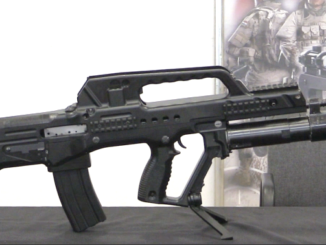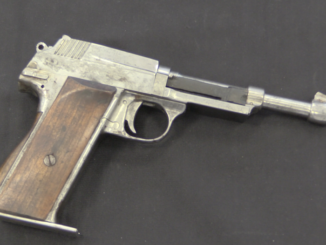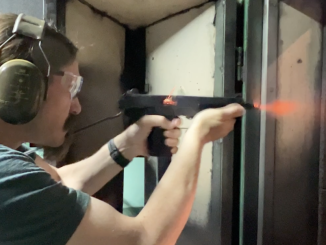There was a fair amount of small arms production in Croatia during the breakup of Yugoslavia, but most of it was not particularly high quality. After the government of Croatia had become established, it looked to arm a formal military, and turned to the Elmech company to produce a sniper’s rifle. The result was the EMM-992 in .300 Winchester Magnum and a companion rifle in 7.62x51mm NATO, the EM-992. Adopted by the Croatian military and police forces in 1992, production ran until about 1997. It is not clear how many were made in total, although the majority were the .300 WM model.
Mechanically, the rifle is a simple push-feed, rotating bolt system. It uses a detachable magazine (unfortunately missing on this example) that could hold either 5 or 7 rounds (I presume 5 in .300WM and 7 in 7.62 NATO). The barrel is free floated, and has integral porting at the muzzle. The trigger is a commercial Timney unit, and the scope chosen was the Leupold 3.5-10 x 24mm. A commercial Harris bipod and composite wood stock round out the elements of the rifle. They apparently served well, but have since been replaced in military service by the Sako TRG-42.
Interestingly, a number of Elmech rifles have been documented in use in Syria, by ISIS and other groups. This particular example was imported into the US directly from a Croatian police department.
Thanks to The Mosin Crate for the loan of this rifle! If you know of a source for a magazine to fit it, please contact them or me; it would be great to find one to make the gun complete.




By coincidence or not but that rifle looks so much like Tikka M-65. Many details looks so similar to Tikka M-65 that they copied it or, walking on thin ice here but, would it be possible that factory bought the rest of the M-65 parts when Sako was stopping to make Tikka M-55/65 rifles? It would explain a lot, also the barrels could be old Tikka barrels. Time frame would match, last Tikka M-65 rifles were made in 1989.
What comes to magazine, Mdt magazine fits with little adjustment. It´s not original but if the owner wants a working magazine that´s one way to go. Of course Tikka magazine could fit too but those are hard to find and expensive(and not very great mags).
By the way, I´m guessing that the Leupold was 3.5-10x40mm not the 24mm like Ian said.
At the time, there UN embargo on import of firearms and weapons in ex-Yugo countries (thus this domestic development), so not a chance it was factory parts straight from far away Finland. However it is possible that they somehow acquired/imported the barrels, as they were not controlled items.
MiG-21s, Mi-8s and Mi-24s were smuggled, what are some rifle parts? 🙂
Jokes aside, Elmech acquired technical data for new series of rifles in late 1980s with intention of civilian sales. It is unknown (to me at least) where did they acquire it. First prototype of the rifle was produced already in early 1991., and was scheduled to be presented on Novi Sad hunting and fishing fair in summer same year. War intervened however, and weapon was relegated as a military/police sniping rifle.
Even before those rifles that they were making sporting rifles based on Kar98ks (other company that also “produced” a lot of civilian weapons by sporterizing JNA surplus was Sava Kranj). Elmech primary weapon program before 1991. was however mortar ammo. They were also one of the designated wartime weapon overhaul factories.
Oh, and use in Syria is due the sale to the “moderate headcutters” that whole whole lot of Balkan countries (Croatia, Serbia, Bulgaria, Bosnia, Macedonia, ) did with the US blessing. It is still going on, sales are done over Serbian company Tehnoremont, and over Bulgarian company (forgot name), all formally going to Turkey, UAE, Jordan or Saudi Arabia.
I know its a trolling joke, but by the time it came to importing smuggled Mig21s and similar gear (from Ukraine), around 1994. sniper rifles, or any other small arms became in great degree irrelevant to the cause.
There were some metalworking factories, ex. socialist more or less big firms in that region that produced or tried producing mortar shell castings, but I don’t think it is Elmech; that company sounds like it was post 1990. free market organised (small) company with few shareholders, that did not have equipment and capacity, so you probably got here something mixed up.
As for “making” sporting Kar98s, its also possible they did it in ex. Yugoslavia, but it sure must have been a customising job on local gunsmith-workshop scale.
That is because having armaments (especially small arms) factories in socialist Croatia was politically prohibited, although its industrial and technology base (along with Slovenia) was far superior compared to other republics (that is why by the end of the war lot of stuff was completely domestically developed from scratch, and more stuff would have been if the war lasted for few additional years)
In any way, in that region where Elmech was made there is a tradition of many small metal workshops (as there is lot of very small settlements scattered around between hills),
of which at least few clandestinely produced for example more or less crude single shot pistols or hunting rifles/shotguns even during Yugoslavia for their local use,
but that did not mean any of that effort or knowledge of shitty stuff they cobbled up before could be practically used in 1990s battlefields.
However one of them eventually became (in)famous, and put a lot of effort in their products; the makers of Agram 2000.
[quote]
“There were some metalworking factories, ex. socialist more or less big firms in that region that produced or tried producing mortar shell castings, but I don’t think it is Elmech; that company sounds like it was post 1990. free market organised (small) company with few shareholders, that did not have equipment and capacity, so you probably got here something mixed up.”
[/quote]
No, Elmech was originally subsidiary of the larger company, it changed name and became privately owned in 1990s, but the roots were there.
They not only tried they have also produced 82mm mortar ammo. They have also produced parts for 128mm rockets for Plamen MRL.
I was surprised as well when I found out, even if it is only marginally interesting for my research (civilian weapon with a production after 1990).
[quote]
As for “making” sporting Kar98s, its also possible they did it in ex. Yugoslavia, but it sure must have been a customising job on local gunsmith-workshop scale.
[/quote]
It was 1000-1500 converted ones, small numbers compared to Sava Kranj (~15000 converted hunting rifles) or… Gorenje (~10000 converted).
[quote]
That is because having armaments (especially small arms) factories in socialist Croatia was politically prohibited,
[/quote]
Lol, no. It was decided relatively early that one small arms factory was enough and there was no need to move it from Kragujevac, as small arms production during war was considered irrelevant.
Also, there was no tradition of small arms manufacture in Croatia (neither during A-H or Kingdom), unlike in Kragujevac, which possibly played a part also. Where there was a tradition in certain area it was used, no matter the republic – hence Kamnik (Slovenia) being premier powder producer, Zagreb university having strongest rocket/missile program, practically all the ships being built in Croatia etc.
[quote]
although its industrial and technology base (along with Slovenia) was far superior compared to other republics
[/quote]
And was used for a things more complicated than small arms. Forgetting who and how god M-84 tank final assembly? Also it was decided not to build any new arms factores in the parts of Yugoslavia most exposed to a Warshaw pact – Slavonia, Vojvodina, eastern Serbia. Some were however built in Macedonia, but that was regular Yugoslav politicking “developing undeveloped regions”.
[quote]
(that is why by the end of the war lot of stuff was completely domestically developed from scratch, and more stuff would have been if the war lasted for few additional years)
[/quote]
Croatian small arms industry, as impressive and effective as it was during 1991-95 was an offshoot of the old Yugo “wartime depot maintenance”. Which is why you have various SMG designs copying Sten/MP-40/PPSh parts, because those factories that produced them had technical drawings for those parts. Also, with IIRC one exception practically all the people who developed weapons in Croatia worked previously in the Yugoslav arms industry.
[quote]
In any way, in that region where Elmech was made there is a tradition of many small metal workshops (as there is lot of very small settlements scattered around between hills),
of which at least few clandestinely produced for example more or less crude single shot pistols or hunting rifles/shotguns even during Yugoslavia for their local use,
[/quote]
Lol, there was no need for clandestinely produced single shots, since arms license was easier to get in Yugoslavia than in any current successor state. 🙁 There was some “workshop” production in Bosnia, but that was dying thing from the Ottoman times, at the level of Pakistani/Afghan tribal arms production, in the ’60s there were TV documentaries about last ones…
Licenced gunsmith workshops were present in almost any town all across ex-Yugoslavia, and a lot of them modified weapons, some of them quite well.
[quote]
…However one of them eventually became (in)famous, and put a lot of effort in their products; the makers of Agram 2000.
[/quote]
What happened with a developer in the end (forgot his name…), there was some lawsuit involving him and even relatively recent (~2010) accusations of the illegal weapon manufacture?
I don’t have the time to dissect your post quote by quote as you did, however I will say (for the record of not involved readers here that are not familiar with the general topic) its clear that you have some knowledge and maybe some facts, but at the same time lot of stuff written is borderline false, exaggerated or jumping to conclusions; intentional or unintentional.
However the topic is very complex and still not investigated throughly, even 25 years after the war, it is possible some aspects never will, so there lies the danger of fabrication of stories and legends to fill the missing fact gaps.
good story 🙂
Might be possible to 3-D print a .308 magazine to fit in the space where a .300 Win Mag magazine should sit.
Only question becomes how thin do the feed lips have to be? My 3-D printed Glock mags designed by Ivan the Troll are working fine, albeit they don’t like steel.
It seems that finding a mag for this rifle, that one more quest…
The second set of numbers on the scope are for determining range. Even a simple duplex reticle can be used as such on a second focal plane scope.
As an example, Let’s guess that a 36″ target fits inside the fine crosshairs at 100 yards at the lowest magnification setting. When you had a 36″ target at an unknown distance, you would adjust the magnification until it fit inside the reticle. You would then glance up at the second set of numbers for a range.
Once the distance was known you would dope the scope and use whatever magnification was desired.
What is “Mauser action” about this? It is push-feed instead of controlled, has internal ejector instead of external, very different extractor, different locking arrangement etc. etc. Really, it is a bolt action like a Mauser is, but there the similarities end.
Here is a 1992. magazine with first article ever about Elmech sniper rifle:
https://hrvatski-vojnik.hr/wp-content/uploads/2017/10/hv_011_91_95.pdf
Rifle that Ian was showing is missing nice “HV” (Croatian Army) crest on the base of the handle, on his rifle it looks sadly and unsightly like it is ripped out.
From another same time period magazine, we have an advert with beautiful girl :
(I hope she trimmed her nails, or at least changed the color, before going into combat 🙂
https://ibb.co/b6629nS